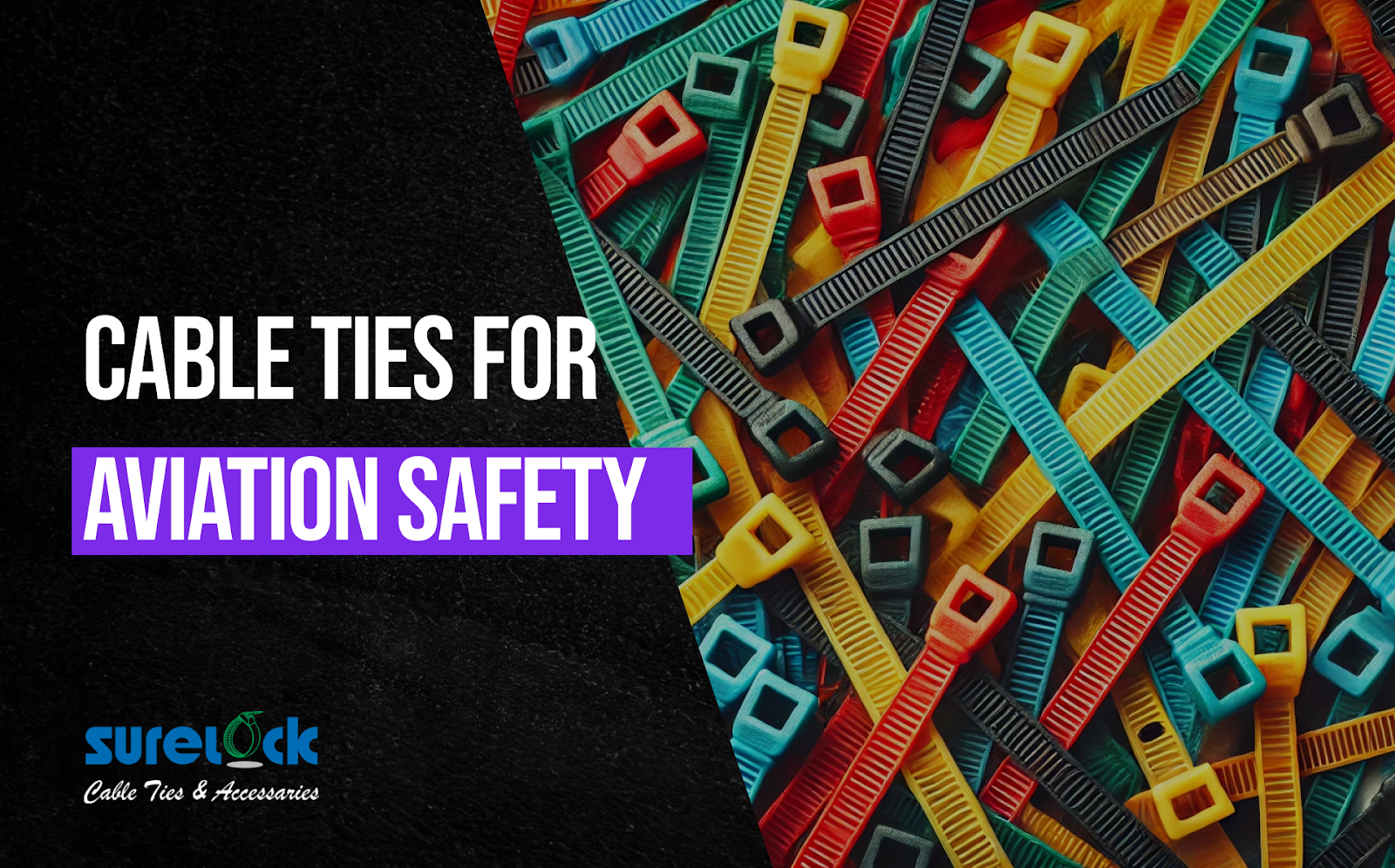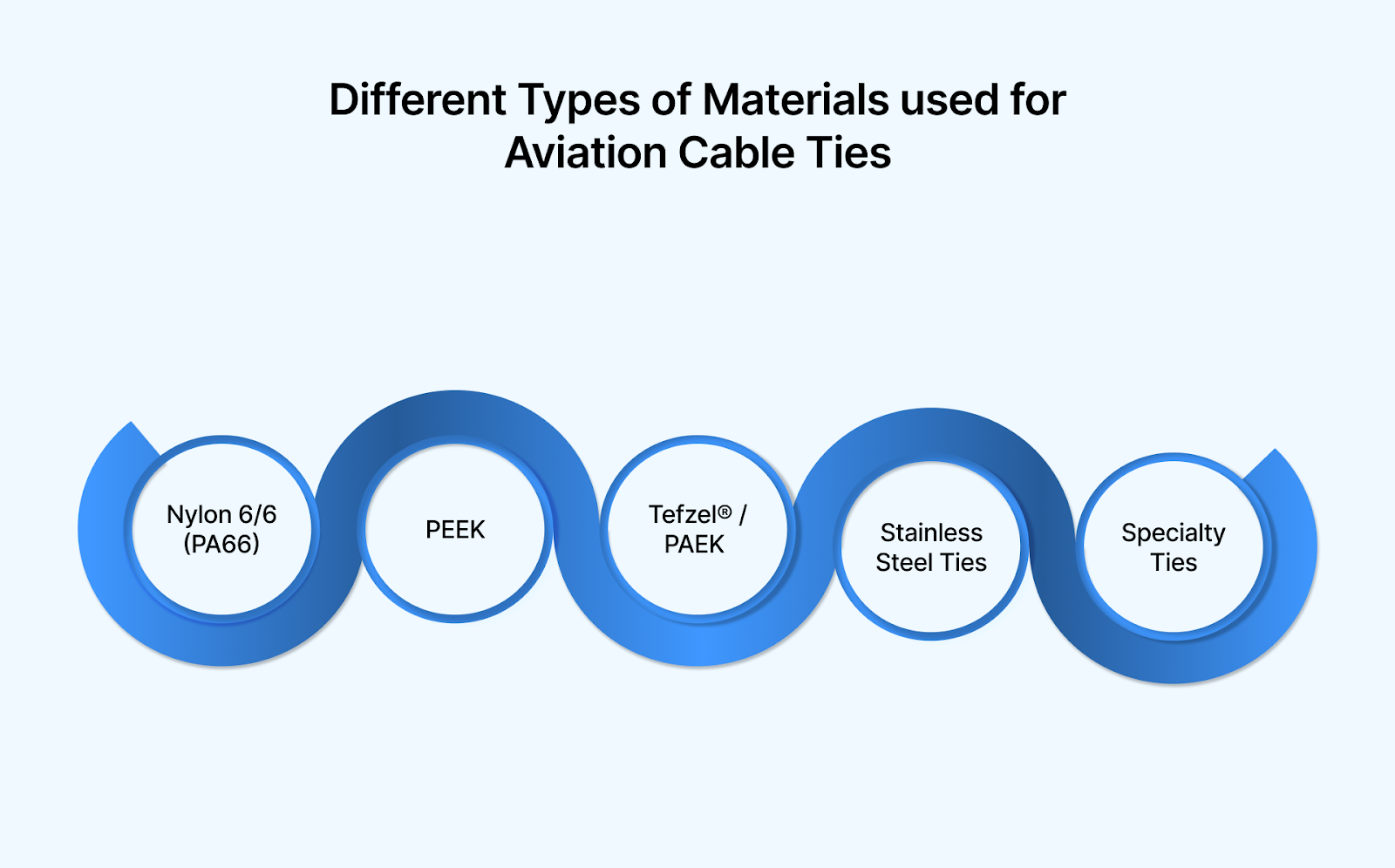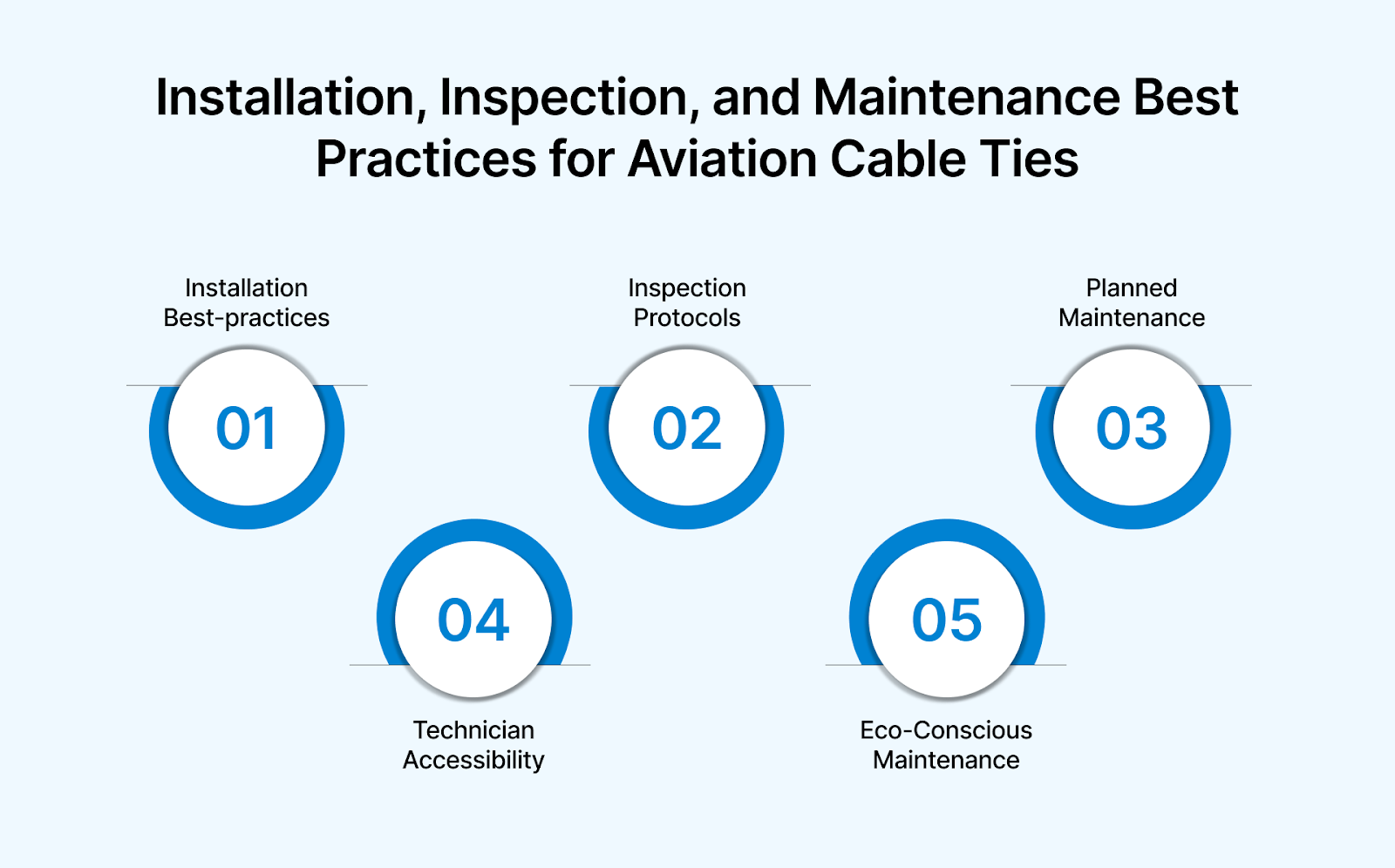Cable Ties for Airline Industries: Ensuring Safety, Performance, and Compliance in Aviation
July 8, 2025

Secure cable management is a critical aspect of aviation safety. In aircraft, every component matters, and even seemingly small items like cable ties can play a crucial role in flight safety. Cable ties bundle and support wiring bundles, preventing loose cables from chafing, shorting, or becoming hazards.
In fact, FAA guidance explicitly treats cable ties as part of the Electrical Wiring Interconnection System (EWIS), warning that their failure could ignite flammable material or damage adjacent circuits. In commercial, military, and private aircraft alike, organized wiring harnesses reduce maintenance errors and improve reliability.
This blog explores how aviation-grade cable ties improve safety, maintenance, compliance, and performance, and what engineers and procurement professionals need to know about materials, standards, types, installation practices, applications, and sourcing.
Different Types of Materials used for Aviation Cable Ties

Cable ties used in aircraft need to handle tough environments—heat, cold, chemicals, and even fire. That’s why choosing the right material for the job is super important. Here's a breakdown of the most common materials used and why they matter:
1. Nylon 6/6 (PA66)
- Temperature Range: –40°C to +85°C (up to +105°C for short bursts)
- Flame Resistance: Can be made to UL 94 V-0 (self-extinguishing)
- Why it's used: It’s strong, affordable, and works great for general cable bundling in less extreme areas of the aircraft—like inside the cabin or cockpit.
- Add-ons: Can be made UV-resistant or heat-stabilized for better outdoor or engine room use.
For general cable bundling solutions, Surelock provides high-quality Nylon cable ties that are both strong and affordable, ideal for cabin or cockpit use.
2. PEEK (Polyether Ether Ketone)
- Temperature Range: –55°C to +240°C
- Flame Resistance: Naturally fire-retardant
- Why it's used: Perfect for high-temperature zones like engines or areas exposed to harsh chemicals. It’s tough, lightweight, and doesn’t burn easily.
- Bonus: Resists acids, fuels, and radiation—great for military aircraft or extreme zones.
3. Tefzel® / PAEK
- Temperature Range: Around –55°C to +200°C
- Flame Resistance: Fire-safe by default
- Why it's used: Ideal for wiring exposed to fuel, oils, or UV rays. Commonly used around the fuselage, wings, or landing gear.
4. Stainless Steel Ties
- Temperature Range: –200°C to 800°C or higher
- Flame Resistance: Completely fireproof
- Why it's used: Best for extreme heat, vibration, or areas near lightning strike zones. Also adds Electromagnetic Interference (EMI) shielding (protects electronic signals).
- Downsides: Heavier than plastic and may corrode without proper coating.
Now that we've nailed down the types of cable ties used up in the skies, let's jump into what keeps everything in check—cue the regulatory standards!
Regulatory and Quality Standards for Aviation Cable Ties
When it comes to aircraft, there’s no room for error—every component must meet strict safety and performance standards, including cable ties. These ties may seem small, but they play a big role in keeping electrical systems organized, safe, and fully operational.
Here’s what you need to know about the key regulations and certifications that aviation cable ties must comply with:
1. UL 94 – Flame Resistance Testing
- What it is: A standard for testing how materials react to fire.
- Why it matters: Cable ties used in aircraft must be flame-retardant. UL 94 V-0 means the material self-extinguishes quickly if it catches fire.
- Use case: Ensures cable ties don’t contribute to spreading flames during onboard electrical fires.
2. FAR 25.853 – Fire Safety for Aircraft Interiors
- What it is: A Federal Aviation Regulation (FAR) focused on the flammability of materials used inside aircraft.
- Why it matters: Cable ties installed in cabins, cockpits, and panels must pass this test to be legally used in commercial aircraft.
- Bonus: Helps protect passengers and crew in the event of onboard fires.
3. RoHS (Restriction of Hazardous Substances)
- What it is: A European regulation that limits toxic substances in electrical and electronic products.
- Why it matters: Aviation cable ties must be free of harmful materials like lead, mercury, and cadmium to protect both people and the environment.
4. REACH (Registration, Evaluation, Authorization, and Restriction of Chemicals)
- What it is: Another EU regulation focused on improving chemical safety.
- Why it matters: Ensures that materials used in cable ties won’t release dangerous substances over time, even under pressure, heat, or wear.
5. MIL-SPEC Standards (e.g., MIL-DTL-32123)
- What it is: U.S. Military specifications for materials used in defense aviation and aerospace.
- Why it matters: These standards guarantee high-performance, durability, and reliability under combat or extreme conditions.
- Use case: Required for aircraft used by defense forces or those operating in extreme environments.
6. SAE-AS23190 – Aerospace Cable Ties
- What it is: A standard specifically for non-metallic cable ties used in aerospace systems.
- Why it matters: Covers requirements for materials, performance, dimensions, tensile strength, and more. It's a must-follow guideline for commercial and defense aviation manufacturers.
7. ISO 9001 & AS9100 – Quality Management Systems
- What they are:
- ISO 9001 ensures quality in general manufacturing.
- AS9100 is the aerospace version, built on ISO 9001 with stricter rules.
- Why they matter: Manufacturers that meet these standards demonstrate commitment to consistent quality, safety, and traceability—critical for aviation parts like cable ties.
8. DO-160 – Environmental Testing for Avionics
- What it is: A standard used to test how well aviation equipment holds up against environmental stress (temperature, vibration, moisture, etc.).
- Why it matters: Cable ties must be tested for vibration resistance and chemical exposure if they're used around sensitive avionics systems.
Every aviation cable tie must meet multiple international and industry-specific standards before it can be installed on an aircraft. These certifications aren’t just paperwork— they’re proof that the cable tie can withstand fire, temperature changes, chemicals, and physical stress without failing.
Surelock’s cable ties are designed to pass these federal regulations, providing peace of mind with every use in commercial aircraft.
Installation, Inspection, and Maintenance Best Practices for Aviation Cable Ties

In the aviation industry, small installation errors can lead to serious issues over time. That’s why correct installation, regular inspection, and ongoing maintenance of cable ties are essential. Following best practices ensures not only the long-term performance of these components but also the safety of the aircraft’s entire electrical system.
Here’s a breakdown of the key steps and tips to follow:
1. Proper Installation Techniques
- Avoid over-tightening: Cable ties should be snug but not too tight. Over-tightening can damage wire insulation, which may lead to short circuits or signal loss.
- Use the right tool: Always use an approved tensioning tool for even, secure fastening without applying too much pressure.
- Position carefully: Place cable ties at regular intervals to prevent sagging or shifting. Keep them away from sharp edges or moving parts to avoid wear and tear.
2. Routine Inspection Guidelines
- Look for signs of wear: Check for cracks, discoloration, fraying, or brittleness. These could indicate heat damage, chemical exposure, or material fatigue.
- Check placement and tension: Make sure cable ties haven’t slipped out of place or become too loose or tight due to vibrations.
- Inspect in all zones: Include engine compartments, avionics bays, passenger cabins, and cargo areas in your inspections. Each environment presents different stressors.
3. Scheduled Maintenance and Replacement
- Follow a maintenance schedule: Include cable tie checks during routine aircraft maintenance cycles, especially in areas exposed to high heat or chemicals.
- Replace proactively: Don’t wait for failure. If a cable tie looks worn or aged, replace it—even if it hasn’t broken yet.
- Document replacements: Keep records of inspections and replacements for compliance and future reference.
4. Ease of Access for Technicians
- Choose reusable cable ties where applicable: In areas that require frequent access, reusable ties save time and reduce waste.
- Organize for accessibility: Bundle cables in a way that allows easy removal or re-routing, especially in critical systems like avionics or communication panels.
5. Environmental Awareness During Maintenance
- Check for environmental impact: Areas near engines or hydraulic systems might expose cable ties to oils, heat, or vibration. Choose the right material and replace more frequently if needed.
- Keep surroundings clean: Dirt or foreign materials trapped under cable ties can damage wires or compromise insulation over time.
Good installation and maintenance practices help extend the life of aviation cable ties and prevent costly system failures. By using the right tools, scheduling routine inspections, and replacing ties before they fail, aircraft technicians can ensure the electrical systems remain safe, organized, and compliant with industry regulations.
Surelock’s range of ties includes designs that ensure secure and damage-free fastening, catering to the precision required in aviation applications.
After digging into the nitty-gritty of installation and maintenance practices, let's check out how these essential ties make a real difference in aircraft day-to-day operations.
Real-World Applications of Cable Ties in Aircraft
Cable ties play a critical role in modern aircraft by keeping complex electrical and mechanical systems well-organized, safe, and functioning reliably. They’re used in almost every area of the plane—from the cockpit to the cargo hold—to help manage cables, reduce risk, and support essential operations.
Here are some key real-world applications where aviation-grade cable ties are used every day:
1. Cockpit and Avionics Systems
- Purpose: To secure wiring for navigation, flight controls, radar, communication, and monitoring equipment.
- Why it matters: These are some of the most critical systems on the aircraft. Disorganized or loose cables can disrupt vital operations or delay emergency responses.
- Application: Heat-resistant, EMI-shielded cable ties help reduce interference and withstand high loads in densely packed avionics panels.
2. Engine Compartments and Exhaust Areas
- Purpose: To manage wiring and tubing in high-temperature zones like near engines, fuel lines, and exhaust systems.
- Why it matters: These areas experience extreme heat and vibrations. Using standard ties here would risk melting or loosening.
- Application: High-temp nylon or fluoropolymer cable ties are used for durability and heat resistance up to 260°C.
3. Cargo Hold and Underfloor Systems
- Purpose: To secure electrical wiring for lighting, refrigeration, sensors, and environmental controls.
- Why it matters: These areas can be subject to chemical exposure and varying temperatures.
- Application: Cable ties with chemical-resistant coatings are ideal to prevent degradation from oils, cleaning fluids, or de-icing agents.
4. Passenger Cabin Wiring
- Purpose: To organize wiring for lighting systems, inflight entertainment, air conditioning, and seat power outlets.
- Why it matters: Properly secured wires keep systems running safely while also helping technicians during maintenance.
- Application: Low-smoke, flame-retardant cable ties are used to minimize fire hazards in passenger-accessible zones.
5. Communication and Antenna Systems
- Purpose: To hold coaxial cables, antenna wires, and satellite communication lines in place.
- Why it matters: Loose or misaligned communication wiring can impact data transfer or navigation accuracy.
- Application: UV-stabilized cable ties with EMI protection help ensure uninterrupted signal strength and long-term durability.
6. Hydraulic and Fuel Systems
- Purpose: To bundle and route control cables and sensor wires near hydraulic lines or fuel systems.
- Why it matters: These areas are sensitive to leaks, pressure changes, and vibration.
- Application: Flame-resistant and chemically inert cable ties reduce risks of ignition or corrosion.
7. Maintenance Access Points
- Purpose: To organize service-related wiring or diagnostic systems that require frequent technician access.
- Why it matters: Quick access is essential during scheduled checks or emergency troubleshooting.
- Application: Releasable or reusable cable ties allow easy removal and repositioning without damaging cables.
Okay, we've seen these cable ties in action, so what should you be looking out for when choosing the right ones for your aviation needs?
Key Considerations When Choosing Aviation Cable Ties
Sourcing the right cable ties for aircraft use isn’t just about picking something that “fits.” It’s about long-term safety, compliance, and reliability in some of the most demanding environments. Here’s what you need to keep in mind:
1. Material Compatibility
- Match to the Environment: Choose materials like nylon, PEEK, or stainless steel depending on the heat, humidity, and chemical exposure in specific aircraft zones.
- Fire Resistance: Aviation cable ties should meet flame-retardant standards like UL 94 V-0 to prevent fire spread in emergencies.
- UV and Moisture Resistance: Especially important for components exposed to sunlight or cabin moisture.
2. Temperature and Vibration Resilience
- Heat Tolerance: Use high-temperature-rated ties for areas near engines or exhaust systems.
- Cold Performance: Ensure ties remain flexible in low temperatures found at high altitudes.
- Vibration Resistance: Select ties that maintain tension under constant aircraft vibration to avoid wire fatigue or failures.
3. Tensile Strength and Load Requirements
- Understand Load Ratings: Ensure the tie’s tensile strength exceeds the expected bundle weight — with a buffer for movement and shock.
- Use Case Fit: Light-duty ties for simple wiring; heavy-duty options for dense or load-bearing cable runs.
4. Installation and Maintenance Needs
- Ease of Use: Low-profile heads and smooth body designs help with tight spaces and faster installation.
- Releasable Options: Useful in areas requiring regular inspections or rerouting of cables.
- Color Coding: Simplifies identification and maintenance, especially in complex systems.
5. Compliance and Certifications
- Look for ties that are:
- Aerospace-rated (e.g., AS9100, ISO 9001)
- Tested for flammability and chemical resistance
- Labeled with batch numbers or part IDs for traceability
- Why it matters: Certified products reduce risks and help pass inspections with flying colors.
Surelock’s cable ties come in various materials and coatings to match the specific environmental needs of any aircraft zone.
Conclusion
When it comes to aviation, every detail matters — even the humble cable tie. These small components play a huge role in keeping aircraft systems secure, organized, and running smoothly. From managing complex wiring in tight compartments to withstanding extreme temperatures and vibrations, aviation-grade cable ties are silent heroes behind the scenes.
But not all ties are created equal. Choosing high-quality, certified, and purpose-built cable ties isn’t just smart — it’s essential for ensuring airworthiness, simplifying maintenance, and protecting passengers and crew alike.
At Surelock, we understand the high stakes of the airline industry. Our cable ties are engineered to meet rigorous safety standards while offering durability, fire resistance, and easy installation. Whether you're outfitting a commercial airliner, cargo jet, or military aircraft, we’ve got a reliable solution tailored for your environment.
Ready to Upgrade Your Aircraft’s Cable Management?
Get in touch with us today to request samples, explore product specifications, or place an order.
Safety and performance start with the right connection — and it begins with Surelock.



